The House of Representatives
The framers uniquely created a bicameral Congress to satisfy both sides of the debate over how states would be represented in the legislative branch. The Great Compromise was reached to please both small and large states. All states have equal representation in the Senate no matter how small or large.
In the House of Representatives, representation is based on the population of each state. In this lesson you will learn the rules of operations, the roles of the leaders, and the structure of committees within the House of Representatives.
Representing "We the People"
Each member of Congress, whether he or she is a Senator or a member of the House, is elected to represent the interests of their constituents. However, the members of the House of Representatives have always been chosen directly by the people, or by a direct popular vote. The Constitution was written to make the House of Representatives the chamber closest to the people.
Read About Congressional Districts.
Qualifications of Representatives
Members of the House of Representatives are directly elected by the popular vote of their constituents for two year terms. Members must be at least 25 years old, citizens of the United States for at least seven years, and residents of the state from which they are elected to qualify for the House of Representatives. Though it is custom, the Constitution does not require that representatives live in the districts they represent. Furthermore, informal qualifications include the ability to raise money and appeal to the voters.
Apportionment in the House
The 435 seats in the House of Representatives are apportioned. Based on the concept of apportionment, each seat in the House represents a congressional district and should represent the same number of people, approximately 700,000. The number varies because every state is guaranteed one seat. However, some states have a population less than 700,000 while others have a population over 700,000 but not enough to merit a second seat.
Explore house.gov to learn more about the House of Representatives.
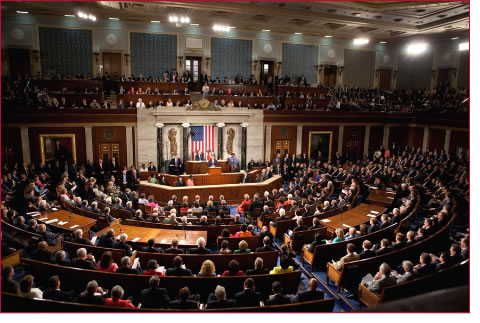
President Barack Obama addresses a joint session of Congress in the House chamber.
Re-apportionment and Gerrymandering
The House of Representatives is required to undergo reapportionment every ten years when each state population is counted by the U.S. Census Bureau to make the districts as equal as possible. Though Congress controls reapportionment, it is left to the states to draw their own district boundaries. Party politics often creeps into the process since the party in power usually draws boundaries to its own political advantage. This process is known as gerrymandering.
Read Gerrymanding -- explained.
This political cartoon, The Gerry-Mander Edit, by Elkanah Tisdale was originally published by the Boston Centinel in 1812. It was drawn in reaction to the new Congressional electoral district of South Essex County created by the Massachusetts legislature to favor the Democratic-Republican Party candidates over the Federalists. Notice the unusual shape of a district resembles a dragon-like "monster."
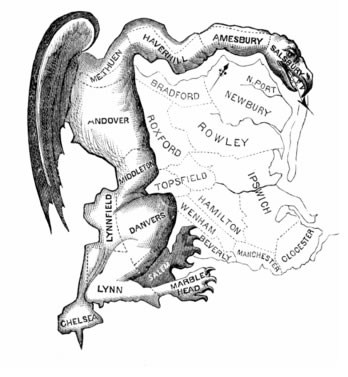
The image is a political cartoon with a strange lizard-like creature wrapped around a map. Federalist newspapers editors thought the district was shaped like a salamander. Hence, the word gerrymander was coined as a blend of salamander and Governor Gerry's last name.
Play The Redistricting Game to learn more about reapportionment.
Speaker of the House
The Speaker of the House is the most powerful member of the House of Representatives and serves as its presiding officer. The Speaker is from the majority party in the House of Representatives and is elected by members of the House. House rules and tradition have given the Speaker power to control business in the House and influence his or her party's political agenda. In addition, the Speaker of the House is potentially one of the most powerful positions in our government since the Speaker is second in the line of succession to the presidency only after the Vice-President.
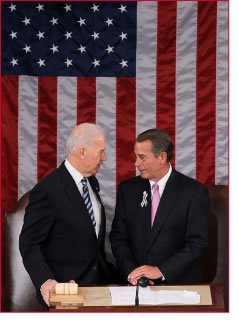
Speaker of the House John Boehner, right, talks with Vice President Joe Biden, the president pro tempore of the Senate in 2014.
As presiding officer, the duties of Speaker of the House include:
• Presiding over debates on the House floor
• Ruling on points of order
• Assigning bills, or proposed laws to committees
• Deciding if a measure comes up for debate and how it is debated
• Assigning House members to committees
Read Speaker of the House.
Other Leaders in the House
In addition to the Speaker, there are several other leaders from both parties in the House of Representatives. There is a floor leader elected by each party to manage the actions and strategies of the party. The majority leader is the floor leader for the party with the most members in the House and serves as the assistant to the Speaker of the House. The minority leader is the floor leader for the minority party and is the main spokesperson for his or her party.
Read Majority Leaders of the House to learn more about the leaders in the House of Representatives.
Watch Majority Leaders of the House (1899 to present)
Click here to view the instructions for logging in to Discovery Education Streaming videos.
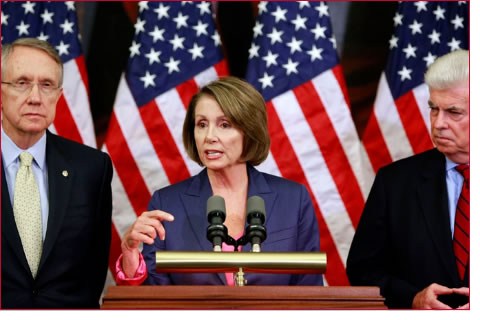
Minority Leader Nancy Pelosi rallying Democrats with the help of Senate leaders.
The party leader may be the spokesperson for each political party, but the whip rounds up the votes. Both parties elect a whip to "encourage" members of their party to support the party's position and to vote with the party leaders. It is the job of the whips to gather information about the votes of all members of the party and keep them from "crossing the aisle" or voting with the other side.
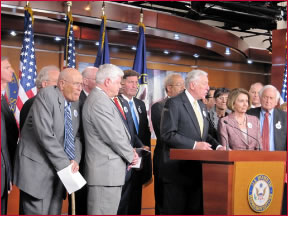
Minority Whip Hoyer and House Democrats unveiled the Make It In America Agenda for the 112th Conference.
The leadership in each party is elected at the beginning of each congressional term at a meeting known as the party caucus.
There are a number of caucuses in Congress including the Congressional Black Caucus and Senate Women's Caucus.

Majority Whip Steve Scalise and House Republicans. The House has passed 364 bills that create jobs, grow the economy and put American families first.
Congressional Committees
Even though committees are not mentioned in the Constitution, it has been said that the real work of Congress happens in committees. There are several types of committees some of which play a significant role in sorting through the many bills introduced in each session to determine which bills are worthy of consideration by the entire legislative body.
Each committee is headed by a chairperson chosen by the majority party. Congress now holds elections for committee chairs with seniority being only one factor in those elections. Members of the House may not always get their requested committee assignments which are usually requested based on personal interests and the interests of their constituents. In most cases, members serve on up to two standing committees and four subcommittees.
Read Kids in the House to learn more about committees.
Rules Committee
The House Rules Committee, also known as "The Speaker's Committee," has vast power. It has two main areas of jurisdiction that include special orders for considering legislation and original jurisdiction matters. The Rules Committee basically sets the rules for how, when, and under what rules debate will take place on a bill.

According to House of Representatives Committee on Rules, "The Committee has the authority to do virtually anything during the course of consideration of a measure, including deeming it passed. In essence, so long as a majority of the House is willing to vote for a special rule, there is little that the Rules Committee cannot do."
Read The Committee to learn more about the House Rules Committee.
Standing Committee
The House of Representatives has twenty permanent committees to make and debate laws called standing committees. Every bill passed through either house in Congress is first considered by a standing committee. Standing committees may also have subcommittees in which a subgroup of members may hold hearings, conduct research, and revise bills on a more specific area of public policy and report back to the committee.
The House Ways and Means Committee is one of the oldest and most powerful standing committees. It is the chief tax-writing committee and exercises jurisdiction and oversight over revenue related to large programs like Social Security and Medicare. The House Ways and Means Committee has six subcommittees.
Click on each link under Standing Committees to learn more about all 20 permanent committees.
Other Committees
The House of Representatives occasionally forms joint committees with the Senate to tackle issues that impact both chambers of Congress. Joint committees do not report on legislation or consider legislation in either house. The House of Representatives also establishes select committees that are temporary and have a specific timeline to complete a specific task. For example, a select committee may be appointed to investigate events surrounding a certain event like the 2012 Terrorist Attack in Benghazi, Libya.
Explore House Committees to learn more about the various committees in the House.

In the image, witnesses offer testimony before the House Select Committee on Benghazi.
Role of the House in the Electoral Process
In addition to the legislative and oversight work done in committees, the House of Representatives has a unique role in the election process of the President. If no candidate gets a majority of the votes in the Electoral College, the House chooses the President. If a House vote is required to decide who will be President, each state gets one vote. This has only occurred twice (1800 and 1824) in our nation's history.
A correction was obviously needed after the 1800 election, due to the unforeseen problem with casting two ballots with the top vote deciding the President and the second highest deciding the Vice-President. The Twelfth Amendment corrected the problem by creating giving each state in the House one vote to choose the President if there is no majority in the Electoral College and giving the Senate authority to choose the Vice-President.